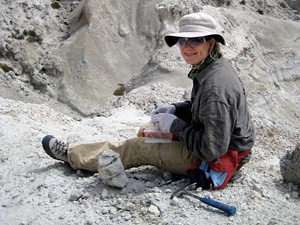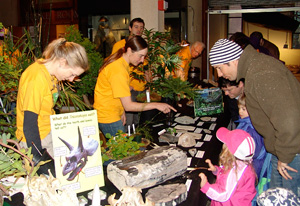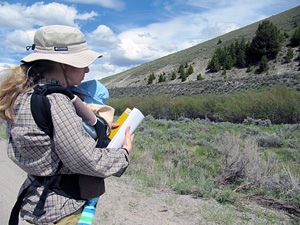 PaleoPeople PaleoPeople
Caroline Strömberg
University of Washington, Seattle, WA, USA
— Interview conducted August, 2011
Dr. Caroline Strömberg received her Ph.D. from the University of California, Berkeley, and is currently the Estella B. Leopold Assistant Professor in the Biology Department and Curator of Paleobotany in the Burke Museum of Natural History and Culture, at the University of Washington, Seattle. Her work focuses mainly on the evolution of grasses and the spread of grassland ecosystems during the Late Cretaceous and Cenozoic and involves fieldwork in North and South America, Europe, Asia Minor, India, and China, as well as labwork and microscopy. |
 |


Dr. Strömberg collecting sediment samples for phytolith extraction at Gran Barranca, Argentina. Photo courtesy of Caroline Strömberg.
|
Q: Why is paleontology relevant today?
A: With paleontology we can learn from the past about how life responds to environmental change — about processes that occur on temporal and spatial scales beyond what we can measure experimentally, and that can be important in understanding how the Earth functions. And now that we're facing rather dramatic climate change, paleontology is more relevant than ever.
Q: How did you end up becoming a paleontologist?
A: I was a "dinosaur girl" when I was little, but I also liked whales and other animals. When I was a teenager I started thinking about how life evolved on Earth and where we come from; you know, existential questions. So I started reading more about the evolution of life on Earth. I also loved geology. I had an inspirational high school geology teacher who made me see that paleontology was where I could get most of my questions answered; I became fascinated with it and followed that passion. I wasn't concerned about what kind of job I could get later.
Q: How did you end up in paleobotany?
A: Ah! I was always curious about animals and vertebrates in particular; how they evolved as a result of environmental change. It wasn't until I came to Berkeley — I was an exchange student for a year as an undergrad — that it occurred to me that plants really held the key to what was going on with the vertebrates, because at the base of many food chains there are the primary producers: plants. I'm still very interested in the interactions between animals and plants but now from a paleobotanical perspective.
Q: Was there any person who influenced your development as a scientist in general or as a paleontologist specifically?
A: That geology teacher I mentioned was very influential — he was very enthusiastic and supportive and he knew a lot more than most high school teachers. He was just a fountain of knowledge with cool perspectives on biology and geology. I was also very inspired by Stella Brewer Marsden, Jane Goodall, Dian Fossey — female ecologists studying primate behavior. I found their research really fascinating — people who go out in the field and push the envelope.


Dr. Strömberg and her graduate student, Regan Dunn, man the table with plant fossils at the Dino Day open house at the Burke Museum. Photo courtesy of Caroline Strömberg.
|  |
Q: What is the particular area of paleobotany that fascinates you?
A: I'm interested in the evolution of grasses and the spread of grassland ecosystems over the past 70 million years or so — the Late Cretaceous and Cenozoic. I find this topic fascinating because 70 million years ago there were no grasses, and today grasses are everywhere — they cover up to 40% of the Earth's land surface. Most of what we eat today is grasses — humans and many other species depend on them so it's hard to imagine Earth without them. It probably took no more than 25 or 30 million years for Earth to be transformed from a world with very little grass into a more or less grass-dominated one and it's fascinating to me how a single group of organisms can completely transform large parts of the Earth in such a short time … and the ramifications of that, in terms of animal evolution. I'm also interested in how climate and tectonics may have influenced the transformation.
Q: What are some of the research projects that you've worked on?
A: I've studied the spread of grass-dominated ecosystems in the Great Plains of North America and also in the eastern Mediterranean. We think we know a lot about the spread of grasslands by looking at the vertebrates, so I have added the fossil record of plants to that to test some of these vertebrate-only hypotheses. For example, people have used the evolution of the horse in North America as a way to infer when ecosystems transformed from forests to grasslands. I've tested that by looking at the plants and found that the vegetation actually changed many millions of years earlier than we thought.
And I've also been working on the evolution of angiosperms in general. I've looked at a Late Cretaceous flora that was preserved as an ashfall flora, essentially providing a "geologic snapshot in time" of that landscape. We've been able to use the distribution of plants in that landscape, as well as different soil parameters that we've been able to measure — such as the organic content of the soil — to figure out what sort of niches early flowering plants had in that landscape before they became dominant.
Q: What problem or question are you working on and what attracted you to the problem?
A: One of the projects I'm involved in is looking at the spread of grasslands in South America. I'm excited about this — it's not just a repetition of an old theme here. Ecosystems change in response to changes in climate, but the effects and pace of those ecosystem changes may be completely different on different continents. In fact, based on the vertebrate fossil record, the changes we see in South America took place almost 20 million years earlier than anywhere else. So it's thought that the earliest grasslands on Earth must have developed in South America. Of course I was extremely curious to see whether this was true, so right now we're working on adding the fossil record of plants to that of the animals … and it's turning out to be very interesting!
 |


Dr. Strömberg conducting field work in southwestern Montana and Idaho with her son, Fredrik Wilson. Photo courtesy of Caroline Strömberg.
|
Q: What would you say is the most exciting or interesting thing that has happened during your career in paleontology?
A: I would say that my big "eureka moment" came at SVP (the Society of Vertebrate Paleontology annual meeting) in 2004 when I was looking at photos sent to me by some Indian colleagues. They'd been examining dinosaur coprolites, using processing techniques to extract fossil silica, i.e., phytoliths. In the photos, there it was: a grass phytolith — and I was just blown away because there was no doubt that it was a grass. At that time, it was the oldest confirmed grass fossil and it showed that dinosaurs ate grasses to some extent. For me it was revolutionary — I remember jumping up and down. That was my most exciting moment.
Q: What is a typical day like for you?
A: A lot of my days are pretty exciting and extremely variable. I'm partly in the biology department so I teach and mentor students; I have two graduate students, one postdoc, and ten undergrads in my lab; I go to meetings, do research, write, and spend an inordinate amount of time answering e-mails. I'm also a curator in the Burke Museum so I work in the collections, organize and supervise students and staff that help catalog specimens, work on exhibits, do public outreach, and field work.
And now I'm a mother. My husband (Greg Wilson, a professor in the same department) and I have had to become much more efficient with our time. I feel that my time with my son enriches my time at work and vice versa, and although it's more stressful than it was before it's also more fun.
Q: What advice would you give young people interested in becoming paleontologists?
A: I would say that if you truly love paleontology, you should go for it. Get out in the field with someone who does paleontology and/or work in someone's lab to get the experience. Paleontology might be one of those subjects that a lot of people are fascinated by, but just like any other science or job, there are a lot of dull moments where you just do boring, repetitious tasks. If you're not passionate about the questions that you're attempting to answer or other aspects of the job, then that's going to kill your interest. I would recommend "trying it on for size" before applying to grad school.
|



